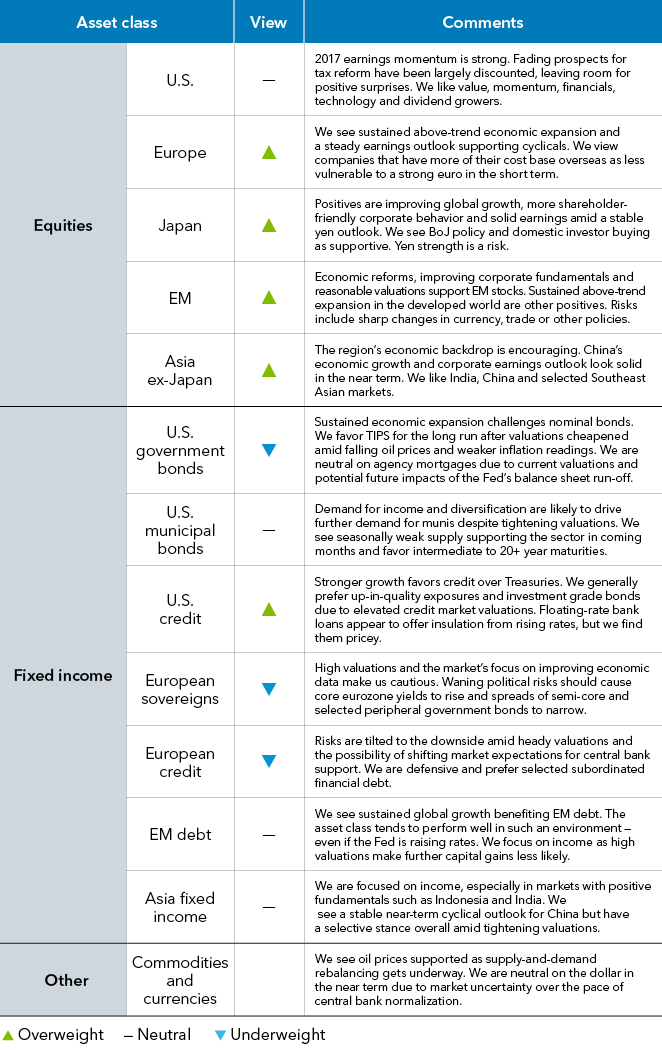by Richard Turnill, Global Chief Investment Strategist, Blackrock
It’s time to prepare portfolios for the remainder of the year. Richard shares investing ideas to consider.
It’s hard to believe that we’re already a few weeks into the second half of 2017. The midway point is traditionally a good time to take a step back and prepare portfolios for the remainder of the year.
We see investing in the third and fourth quarters occurring against a backdrop of sustained and synchronized economic expansion, structurally lower growth and interest rates, and ongoing low volatility. What does this mean for portfolios? We share a few of our investing preferences below, all featured in our Global Investment Outlook Midyear 2017.
Stocks over bonds
The latest earnings season has affirmed our positive view on equity fundamentals, and we see solid equity returns ahead in the second half. At the same time, global economic expansion and monetary policy normalization point to a gradual rise in bond yields over the next five years. Long-term rates are being held down by structural factors including plentiful global savings, providing a favorable backdrop for equities. The earnings yield (earnings per share divided by the share price, or the inverse of the price-to-earnings ratio) still looks attractive versus real (after inflation) bond yields, meaning stocks may be cheaper than they look in a low-rate world.
There are risks to our view. The share of income going to labor (wages) is historically low, and corporate margins are elevated. Any policies that reverse this trend—or labor shortages causing wages to spike—could erode margins and equity valuations. In the final analysis, however, we believe investors are being paid to take equity risk against the backdrop of low rates.
Non-U.S. equities over U.S. peers
We like the U.S. market, but we think higher returns can be found in emerging markets (EM), Japan and Europe, as we note in our new podcast. We see opportunities in EM equities, assuming no sharp changes in currency, trade or other policies. Economic reforms, improving corporate fundamentals and reasonable valuations provide support. Elsewhere, we see a number of positives supporting the Japanese market, including more shareholder-friendly corporate behavior, ongoing ultra-easy monetary policy, low valuations and solid earnings. That said, a stronger yen is a risk.
European equities have done well this year, but they are still trading at a valuation discount to U.S. peers. We believe there’s further scope for this valuation gap to close, given the European economy’s strong fundamentals and a decline in populism. But a stronger euro could slow the pace of earnings growth among European companies, and other risks include politicians not delivering on reforms, the European Central Bank (ECB) winding back its stimulus too soon and renewed political instability in Italy.
Risk-seeking equity style factors over defensive ones
Today’s economic regime favors risk-seeking style factors over defensive ones, we believe. The momentum factor—securities with strong recent price gains—has outperformed in economic expansions, our Factor-based Strategies Group’s analysis of U.S. factor performance since 1990 suggests. It has historically outrun the broader market, but with periodic sharp drops. The biggest dips have coincided with recessions and financial crises.
Today’s low-volatility environment coupled with a sustained economic expansion bode well for momentum, we believe, and we like the momentum factor, even if its performance could be prone to short-lived reversals. A sharp drop in tech stocks in mid-June illustrated the risks of momentum breaks. Momentum drawdowns typically last two months or less, our analysis shows. And they are typically buying opportunities, provided there are no economic or financial shocks to today’s low volatility regime. We advocate tilting style factors throughout the economic cycle, but believe exposure to multiple factors may help provide diversification overall.
Credit over government bonds
We prefer credit to sovereigns, as we believe investors are still being paid to take risk/carry. However, we see more reason to be selective within credit markets than we did at the beginning of the year. Future credit market returns are likely to be more muted than in the recent past, and tight spreads leave little room for error. We prefer U.S. investment grade bonds against this backdrop of reduced compensation for credit risk. We are neutral on U.S. high yield and prefer up-in-quality names. We are underweight European credit, as ECB purchases and negative rates have helped lead to steep valuations. We like selected EM debt, an asset class global growth favors, even if the Federal Reserve is raising rates.
Looking for more investing ideas? Find more in our asset class views table below as well as in our full Global Investment Outlook.
Richard Turnill is BlackRock’s global chief investment strategist. He is a regular contributor to The Blog.
Investing involves risks, including possible loss of principal. International investing involves special risks including, but not limited to currency fluctuations, illiquidity and volatility. These risks may be heightened for investments in emerging markets. Fixed income risks include interest-rate and credit risk. Typically, when interest rates rise, there is a corresponding decline in bond values. Credit risk refers to the possibility that the bond issuer will not be able to make principal and interest payments.
This material is not intended to be relied upon as a forecast, research or investment advice, and is not a recommendation, offer or solicitation to buy or sell any securities or to adopt any investment strategy. The opinions expressed are as of August 2017 and may change as subsequent conditions vary. The information and opinions contained in this post are derived from proprietary and nonproprietary sources deemed by BlackRock to be reliable, are not necessarily all-inclusive and are not guaranteed as to accuracy. As such, no warranty of accuracy or reliability is given and no responsibility arising in any other way for errors and omissions (including responsibility to any person by reason of negligence) is accepted by BlackRock, its officers, employees or agents. This post may contain “forward-looking” information that is not purely historical in nature. Such information may include, among other things, projections and forecasts. There is no guarantee that any forecasts made will come to pass. Reliance upon information in this post is at the sole discretion of the reader.
©2017 BlackRock, Inc. All rights reserved. BLACKROCK is a registered trademark of BlackRock, Inc., or its subsidiaries in the United States and elsewhere. All other marks are the property of their respective owners.
Copyright © Blackrock
















